This article may contain affiliate links. We may earn a commission if you make a purchase through them. Thanks for supporting the blog! Informational only – not financial advice. Always consult with a licensed financial advisor.

💼 Introduction: The New Face of Wealth Diversification
For ultra-high-net-worth individuals, traditional portfolios of stocks, bonds, and mutual funds simply don’t tell the whole story. In the world of elevated finance, luxury asset classes are not just vanity buys — they are strategic tools for wealth preservation, status, and legacy.
From rare art and vintage automobiles to collectible watches, private jets, fine wine, and even rare musical instruments — alternative luxury assets combine aesthetic appeal with real financial upside. These investments often behave differently than traditional markets, providing insulation from inflation, geopolitical turmoil, or systemic banking risk.
“When you buy something rare and exquisite, you’re not just investing in a product — you’re investing in a culture, a market, and often, a future story.” – Jean-Marc Pontroué, CEO of Panerai
This guide explores the most prominent luxury asset classes, how they perform over time, and why they’re increasingly a core part of wealth-building strategies for the world’s elite.
🎨 Fine Art: Timeless Beauty with Generational Value

Art isn’t just for museum walls or elite galleries. For the affluent investor, it represents one of the most powerful and rewarding luxury asset classes in existence — blending cultural relevance, aesthetic fulfillment, and financial strategy. Fine art has consistently proven its ability to withstand market volatility, hold long-term value, and transmit legacy across generations.
Why Wealthy Investors Love Fine Art:
- Non-Correlated Returns:
One of the most appealing characteristics of fine art is that it is largely unaffected by fluctuations in the stock or bond markets. During times of economic downturn or inflation, high-end artwork tends to retain — or even increase — in value. It offers diversification in its purest form, serving as a buffer against systemic risk. - Prestige & Legacy:
Art is not just a financial tool; it’s a form of identity. Hanging an original Rothko, Kusama, or Monet in your home or office signals refined taste, cultural literacy, and deep social capital. Collectors are often known as much for their art portfolios as for their net worth. Moreover, passing on prized pieces to heirs builds both a financial and emotional legacy — creating heritage, not just holdings. - Tax & Estate Planning Advantages:
Savvy investors use artwork in estate strategies — donating to museums for deductions, placing collections into private trusts, or leveraging charitable remainder trusts (CRTs). Some jurisdictions offer tax deferral options through art-related 1031 exchanges or art loans, making it a sophisticated planning tool for ultra-high-net-worth families. - Scarcity Drives Value:
There will never be another Leonardo da Vinci. The finite nature of masterworks and even limited-run modern pieces ensures long-term scarcity. As global wealth grows — particularly in emerging markets — the number of qualified buyers increases, while available supply remains fixed. That dynamic fuels aggressive long-term appreciation.
“Art is the one asset class where your emotional return often outweighs your financial one — and still builds generational wealth.”
— Amy Cappellazzo, Art Advisor & Former Sotheby’s Chairman
Data-Backed Performance
The Knight Frank Luxury Investment Index reports that fine art rose by 91% over the past decade (2013–2023), outperforming many blue-chip stocks and even luxury real estate in key global markets. Works by established names like Warhol, Basquiat, and Banksy continue to break records at Christie’s and Sotheby’s auctions — with new buyers entering from Asia, the Middle East, and digital-first wealth sectors.
For example:
- A Basquiat painting bought for $19,000 in the 1980s sold for $110 million in 2017.
- The contemporary art market alone grew 14% in 2023, despite a global slowdown.
Emerging Trends in Art Investing:
- Digital Art & NFTs:
While the NFT boom has leveled out, blue-chip digital assets like Beeple’s “Everydays” and curated projects tied to real-world institutions are gaining legitimacy. For collectors with a future-facing mindset, this category offers speculative upside and first-mover cultural advantage. - Fractional Ownership Platforms:
Not everyone can drop $10 million on a Warhol. That’s where platforms like Masterworks and Artex step in, allowing accredited investors to buy shares in valuable works. This approach is revolutionizing access to the art market while still focusing on traditional long-term appreciation. - Art as Collateral:
High-net-worth individuals now use their art portfolios as a form of liquidity. Private banks and boutique lenders offer art-backed loans, often at lower interest rates than unsecured lines. This means collectors can unlock capital without ever having to part with a cherished piece — making their artwork work for them.
Key Considerations:
Investing in art is not without nuance:
- Provenance & Authentication: Always work with reputable dealers and auction houses to avoid forgeries or inflated pricing.
- Storage & Insurance: Art must be climate-controlled, properly secured, and insured at high value — which adds to ongoing costs.
- Liquidity: Selling high-value art takes time, expertise, and often a global auction calendar. It’s not a fast-cash investment.
But for those willing to approach it with care and strategy, the rewards are multi-dimensional. You’re not just buying an object — you’re curating a legacy, entering a global collector network, and positioning yourself as a guardian of cultural wealth.
🚘 Collector Cars: Driving Passion and Performance into Your Portfolio
For many luxury investors, collector automobiles offer a rare blend of beauty, utility, scarcity, and adrenaline. These aren’t just weekend toys or garage trophies — they’re rolling assets, with many appreciating faster than stocks or gold under the right conditions. In fact, a properly curated car collection can outperform major asset classes while delivering the joy of ownership in a uniquely visceral way.

The Allure of Automotive Investing
From vintage Ferraris and Aston Martins to rare Porsches and bespoke McLarens, collector cars combine engineering excellence with artistic craftsmanship. For high-net-worth individuals, the appeal is multifaceted:
- Tangible and Enjoyable: Unlike stocks, you can drive this investment — or proudly display it in your garage or showroom.
- Cultural Status Symbol: Classic and exotic cars often reflect eras, milestones, or innovations in design and performance. Ownership communicates legacy, taste, and elite access.
- Rarity Fuels Demand: Limited production runs, discontinued models, and custom commissions make certain vehicles highly sought after — especially when coupled with historical provenance.
“A collector car is a sculpture you can drive — a rare object that performs and appreciates at the same time.”
— Simon Kidston, International Car Broker
Market Performance by the Numbers
According to the Knight Frank Wealth Report, classic cars appreciated by 185% over the last 10 years, making them one of the best-performing alternative asset classes globally. Iconic models — like the 1962 Ferrari 250 GTO or the McLaren F1 — consistently break auction records and are seen as the “Picassos of the pavement.”
Notable benchmarks:
- A 1962 Ferrari 250 GTO sold for $70 million privately in 2018.
- The McLaren F1, originally priced under $1 million in the 1990s, now fetches $20–$30 million in pristine condition.
- Porsche 911s from certain decades have doubled or tripled in value in less than a decade.
High-end cars often hold or gain value faster than luxury real estate, art, or even certain private equity portfolios — particularly during periods of inflation when tangible assets shine.
Entry Points and Strategies
While seven- and eight-figure cars make headlines, many collectors start with:
- 1980s/1990s nostalgia vehicles (early Lamborghinis, BMW M series, Japanese GT-Rs)
- Race-worn editions with documented history
- Coachbuilt cars from luxury brands like Bentley Mulliner, Rolls-Royce, or Zagato
Savvy investors look for:
- Low production numbers (under 500 units)
- Original parts and documentation
- Celebrity or motorsport provenance
- Limited edition supercars with modern tech and retro flair
Additional Considerations:
- Storage and Maintenance: Vehicles must be stored in climate-controlled garages, driven regularly, and maintained by specialists to retain value.
- Insurance: Coverage for high-value vehicles requires specialty insurers like Hagerty or Chubb.
- Auction vs. Private Sale: Auctions create bidding wars and headlines, but private collectors often pay more for discreet, off-market deals.
Classic car investing isn’t just about resale. For many, it’s about community and connection — joining exclusive clubs, attending Pebble Beach or Villa d’Este, and gaining access to a lifestyle few ever touch.
And with the rise of EV mandates and emissions regulations, classic gas-powered icons are becoming cultural artifacts — and potentially even more valuable over time.
⌚ Luxury Watches: Precision, Prestige, and Portable Wealth
For generations, luxury timepieces have symbolized more than just timekeeping — they are heirlooms, investments, and icons of achievement. Whether strapped on a wrist or stored in a vault, high-end watches have become one of the most accessible, liquid, and respected luxury asset classes in the world.
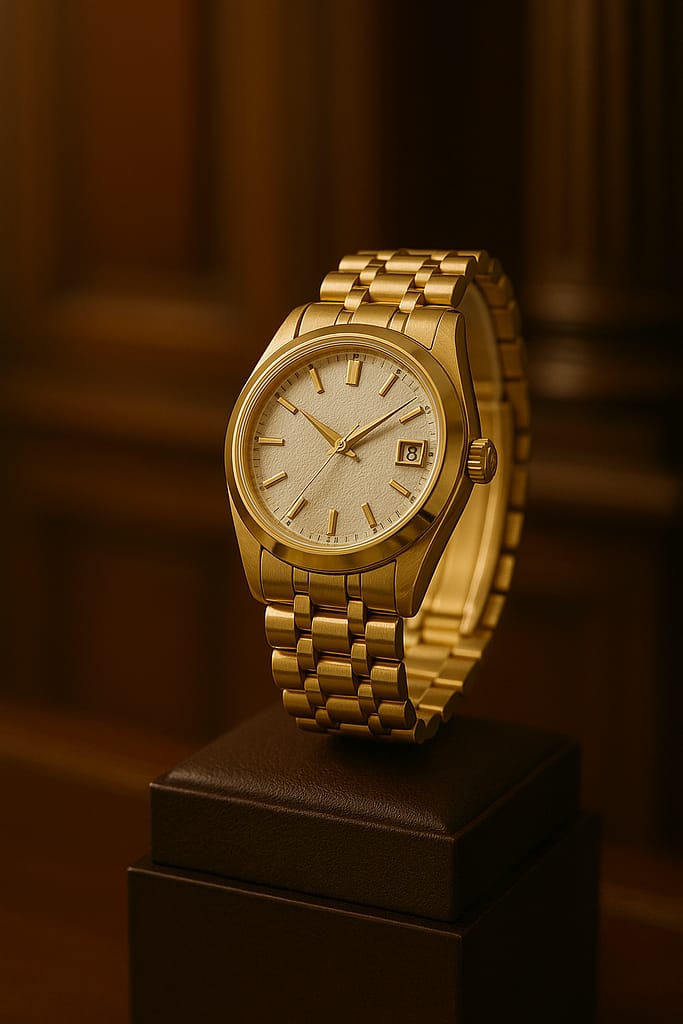
Why Wealthy Investors Favor Watches
- Portability of Value: Unlike a Picasso or a Pagani, a Rolex Daytona or Patek Philippe Nautilus can go unnoticed on your wrist — while holding six or even seven figures in value.
- Steady Appreciation: Limited releases, brand prestige, and global demand have made high-end watches consistently gain value, even during downturns.
- Dual Identity: Luxury watches serve both as wearable expressions of style and status and as financial instruments with serious resale power.
- Legacy Appeal: Many collectors begin their journey by inheriting a family timepiece. Gifting or collecting watches becomes a multi-generational tradition — one that blends emotional and economic significance.
“You never actually own a Patek Philippe. You merely look after it for the next generation.”
— Patek Philippe Ad Campaign
This iconic slogan captures the core of what makes watch investing unique: it’s not just about making money — it’s about marking milestones and building legacy through craftsmanship.
Key Brands That Dominate the Market
Certain names dominate the investment-grade market:
- Rolex: The undisputed king of demand, especially with models like the Daytona, Submariner, and GMT-Master II. Waitlists are often years long.
- Patek Philippe: Known for complication watches, understated elegance, and extreme scarcity.
- Audemars Piguet: The Royal Oak line has become a cultural phenomenon and investor favorite.
- Richard Mille: Futuristic, ultra-limited pieces with celebrity backing and sky-high resale values.
- F.P. Journe, Vacheron Constantin, A. Lange & Söhne: Independent and elite brands with niche collector appeal and rising secondary values.
Appreciation in Action
Watch values have skyrocketed over the last decade. For example:
- A Rolex Paul Newman Daytona that sold for under $100,000 in the early 2000s can now fetch over $1 million.
- The Patek Philippe Nautilus 5711 retailed at under $30,000 but reached $150,000+ on the resale market due to discontinuation.
- Richard Mille models often double in value upon resale, especially limited runs with F1 or tennis affiliations.
Even during global uncertainty, watches hold firm — functioning as safe-haven assets with high liquidity and global demand.
Smart Investment Strategies
- Buy What You Love — and Know: Emotional connection matters, but so does deep brand and model research.
- Go Limited: Limited-edition runs, discontinued models, and rare dials offer the best upside.
- Maintain Flawless Condition: Original papers, boxes, and untouched finishes dramatically affect resale.
- Use Trusted Dealers: Work with authorized dealers and certified pre-owned platforms like WatchBox, Chrono24, or Sotheby’s.
Some investors even opt for watch safes that double as humidors, wine storage, or kinetic winders — turning their portfolio into a display piece.
Beyond the Numbers
Luxury watches aren’t just about returns. They are about time itself — how we mark it, honor it, and celebrate the moments that define us. From boardroom power symbols to private rewards for personal milestones, timepieces fuse purpose and passion better than nearly any other asset.
👜 Rare Collectibles: From Whiskey to Hermès — The Hidden Wealth in Lifestyle Luxuries
For the refined investor, luxury doesn’t stop at art, cars, or watches. A rising number of ultra-wealthy individuals are diversifying into rare collectibles — high-end lifestyle goods that blend beauty, craftsmanship, scarcity, and status. From aged single-malt Scotch to Hermès Birkin bags, these objects of desire are becoming powerful, uncorrelated asset classes in their own right.
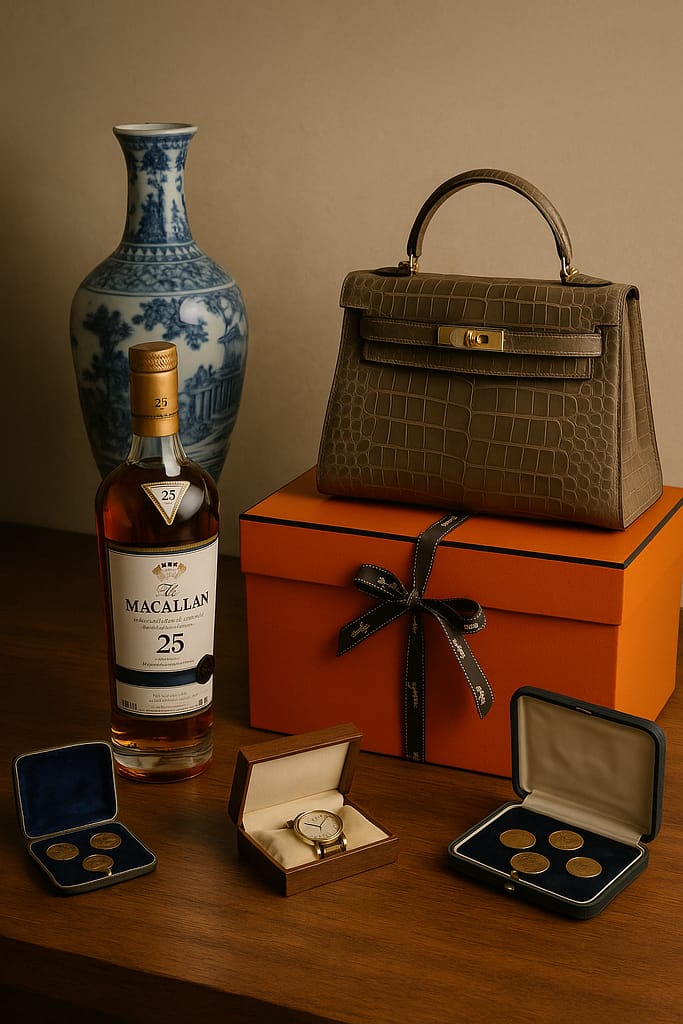
Why Lifestyle Collectibles Are Gaining Traction
In a financial world dominated by stocks, real estate, and cryptocurrency, rare collectibles stand apart — offering both aesthetic pleasure and financial performance. Collectibles serve as a hedge not just against inflation, but also against dull portfolios. More importantly, they are cultural capital, conveying a sense of identity and taste that no spreadsheet ever could.
These investments are often born out of personal passions — a love for vintage Chanel, a fascination with Japanese whiskey, or a thrill for rare writing instruments. But for savvy collectors, that passion is supported by hard data: many collectibles consistently outperform traditional assets in terms of CAGR (compound annual growth rate), especially when acquired thoughtfully and held strategically.
“True luxury is not about logos. It’s about legacy, rarity, and refinement.”
— Françoise Montenay, Former Chairwoman of Chanel
🔥 Top Collectible Categories With Serious Investment Power
🥃 Fine Whiskey & Rare Spirits
What was once a connoisseur’s indulgence has become a legitimate financial instrument. Aged whiskies — particularly from Scotland and Japan — are fetching millions at auction, driven by global scarcity and surging demand from Asia and the Middle East.
- Macallan 1926: Bottled in 1986, a bottle from this limited cask sold for $2.7 million at Sotheby’s in 2023.
- Yamazaki 55-Year: Released in limited numbers, it commands $700,000+ per bottle on the secondary market.
- Pappy Van Winkle 23-Year Bourbon: Originally retailing for under $300, now consistently sells for $5,000–$10,000.
Investors often partner with specialized firms like Rare Whisky 101 or CaskX to build curated portfolios, complete with bonded warehouse storage, insurance, and global resale networks.
👜 Designer Handbags as Portable Wealth
Once seen as indulgent accessories, designer handbags — especially from Hermès — are now portfolio-grade assets. The resale market is booming, and top auction houses like Christie’s and Sotheby’s now run dedicated handbag sales alongside watches and jewelry.
- Hermès Birkin: Appreciates 14% per year on average, outperforming the S&P 500 and gold in many time frames.
- Himalayan Crocodile Birkin: Made with albino Niloticus crocodile and diamond hardware, one sold for $437,000 in Hong Kong.
- Chanel Classic Flap Bag: Limited runs in exotic leather or discontinued colorways are now auction favorites, often doubling in value within five years.
The key to handbag investing is access — and that’s part of the appeal. You can’t simply walk into an Hermès boutique and buy a Birkin. You must build a relationship, shop the brand loyally, and sometimes wait years. That manufactured scarcity ensures long-term demand — and rising resale prices.
✒️ Rare Pens, Jewelry & Decorative Objects
- Montblanc Patron of Art Series: Annual releases tied to figures like Queen Elizabeth I or Leonardo da Vinci often retail for $3,000–$5,000 and resell at 2–5x within a decade.
- Cartier Panthère & Art Deco Pieces: Vintage Cartier jewelry, especially with historical provenance, now commands six-figure auction results.
- Baccarat Crystal, Lalique, and Fabergé: Art glass and objets d’art from these heritage houses are rising in both museum interest and private collector demand.
👟 Emerging: Luxury Sneakers and Streetwear
Millennial and Gen Z collectors are redefining “rare.” Limited-edition drops from Nike, Dior, Louis Vuitton, and Travis Scott collabs are now trading like stocks — some even fractionalized on platforms like Rares and StockX.
- Nike x Louis Vuitton Air Force 1 by Virgil Abloh: Sold for up to $350,000 at Sotheby’s.
- Jordan 1 OGs from 1985: In mint condition, some sell for $50,000–$100,000.
- The resale economy for rare sneakers is now a $10 billion global industry and growing.
📊 Tips to Build a High-Performance Collectibles Portfolio
- Focus on Provenance: Items with a strong backstory, original documentation, or celebrity association hold stronger value.
- Condition is Critical: “New in box,” with no handling, tagging, or alterations, fetches the highest ROI.
- Track the Market: Use auction data from Sotheby’s, Christie’s, Bonhams, and newer platforms like Vestiaire Collective and StockX to monitor trends.
- Think Cross-Generational: Choose collectibles that appeal to younger buyers — their interest is the future resale market.
Collectibles straddle the line between consumption and capital — and for those with refined tastes and long horizons, they deliver on both fronts.
🏠 Luxury Real Estate: A Global Strategy for Wealth, Legacy & Lifestyle
For high-net-worth individuals, real estate isn’t just a place to live — it’s a strategic pillar of wealth preservation, diversification, lifestyle elevation, and legacy building. From Manhattan penthouses to Mediterranean villas and ski chalets in the Swiss Alps, luxury property is one of the most reliable and versatile asset classes in the world.
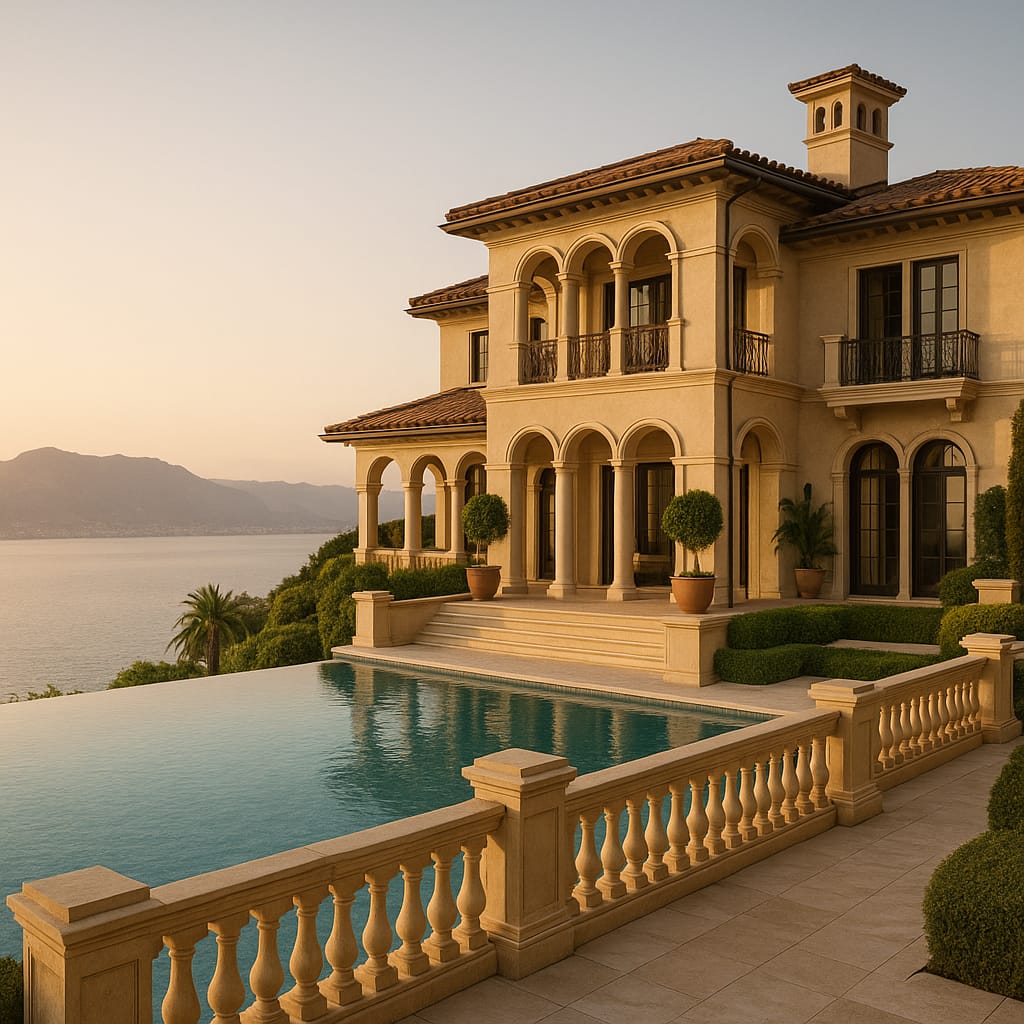
Why the Wealthy Rely on Property
Unlike volatile markets, luxury real estate offers:
- Tangible security in times of economic uncertainty
- Prestige and lifestyle value, offering utility alongside appreciation
- Tax optimization and privacy structures through trusts, LLCs, and offshore entities
- Global mobility, with many countries offering residency or citizenship by investment through high-end property purchases
“Buy land — they’re not making it anymore.”
— Mark Twain
But for the luxury buyer, it’s not just any land — it’s land with provenance, views, exclusivity, and the ability to hold its value even during downturns. Blue-chip properties often become generational anchors for families or vehicles for wealth transfer through smart estate structuring.
🔑 Primary Luxury Real Estate Markets
🇺🇸 United States
- New York City (Manhattan): Trophy penthouses overlooking Central Park remain status symbols. Neighborhoods like Tribeca and the Upper East Side offer top-tier co-ops, private security, and proximity to elite schools and institutions.
- Los Angeles (Beverly Hills, Bel-Air, Malibu): Preferred for estate compounds with tennis courts, home theaters, and studio access. Privacy is key — many properties feature multiple gated layers.
- Miami & Palm Beach: Luxury waterfront condos and homes, especially those with docks and ocean access, appeal to Latin American, New York, and European buyers.
🇬🇧 United Kingdom
- London (Mayfair, Knightsbridge, Belgravia): Long viewed as a safe haven for global wealth. The blend of historic architecture, exclusive clubs, and world-class shopping makes it an enduring hub for real estate investment.
🇨🇭 Switzerland
- Zermatt, Gstaad, St. Moritz: These resort towns are not only about skiing — they are global luxury capitals where high-end chalets appreciate steadily, and ownership often comes with access to elite social circles.
🇫🇷 France
- Paris: Historic flats with Eiffel Tower views and ornate interiors attract buyers from the Middle East and China.
- Côte d’Azur: Villas in Cap Ferrat or Saint-Tropez offer Mediterranean glamour with private beaches and helicopter pads.
🌍 Other Global Hotspots
- Dubai: Zero income tax, global connectivity, and trophy towers like the Burj Khalifa make Dubai a magnet for new wealth.
- Singapore & Hong Kong: Despite strict regulations, luxury properties here are liquid, coveted, and prestige-laden.
- Monaco: With no income tax and sky-high property prices, it attracts royalty, F1 drivers, and ultra-high-net-worth residents from around the world.
💼 How the Ultra-Wealthy Use Real Estate Strategically
- Diversification by Region & Risk Profile
Many wealth managers advise placing real estate assets in different jurisdictions to balance risk — political, economic, and currency-related. - Income Generation
Even high-end homes are frequently rented out. Think $50,000/week rates in Aspen or $25,000/night villa rentals in Ibiza — often during just a few peak months. - Wealth Transfer & Tax Planning
Properties held in trusts or LLCs can help pass wealth to heirs with reduced estate taxes. Some families create dynasty trusts that preserve ownership across multiple generations while shielding assets from litigation or divorce. - Golden Visas & Citizenship-by-Investment
Buying real estate in Portugal, Greece, Malta, or St. Kitts can qualify you for residency or second passports — offering mobility insurance against future geopolitical risks. - Privacy & Security
High-end real estate is often held under layers of corporate ownership, trusts, or offshore vehicles to protect identity and assets. Private compounds, biometric access, panic rooms, and underground garages are increasingly standard features.
🧠 What to Look for in Trophy Real Estate
- Rarity: Unique architecture, historic provenance, or world-class design
- Location + Access: Waterfront, mountain view, or major urban center with elite access
- Security & Privacy: Gated communities, doormen, concierge, and technology
- Architectural Distinction: Designed by starchitects or featuring one-of-a-kind craftsmanship
- Market Resilience: Areas with high demand, limited inventory, and institutional interest
“Buy real estate where the wealthy vacation — not where the average buys.”
— Luxury property strategist insight
🛩️ Private Equity, Hedge Funds & Alternatives: Exclusive Paths to Exponential Wealth
For ultra-high-net-worth individuals, traditional stocks and bonds are only a fraction of the portfolio. The real financial advantage lies in private markets and alternative investments — exclusive deals, elite funds, and off-market opportunities that offer asymmetric risk-reward and the potential for generational returns.

This is the domain of private equity firms, hedge funds, venture capital, distressed asset acquisitions, and structured products — typically only available to accredited investors or through private banking relationships.
What Makes These Investments So Powerful?
- Higher Return Potential: Access to pre-IPO companies, undervalued assets, or leveraged strategies not available in public markets
- Lower Correlation to Stocks: Protects wealth when public equities underperform or enter recession cycles
- Strategic Influence: Investors often gain voting rights, board seats, or influence in decision-making
- Legacy Creation: Involvement in innovation, biotech, real estate development, or industry disruption — not just passive profits
“The truly wealthy don’t just invest in companies. They help build them from the ground up.”
— Financial advisor to Forbes 400 clients
🔍 Private Equity (PE)
Private equity involves buying or investing in private companies with the intent to grow, restructure, or scale — often leading to a profitable exit via IPO, acquisition, or dividend recapitalization.

Typical Strategies:
- Buyouts – Acquiring control of mature businesses to improve efficiency and exit at higher valuations
- Growth Equity – Injecting capital into growing companies without taking control
- Distressed Investing – Acquiring struggling companies at deep discounts and turning them around
Major Players:
- Blackstone, KKR, Carlyle Group, TPG Capital, and Apollo
- Boutique firms and family offices for more tailored investments
Real Wealth Impact:
A $1M investment in a private fund that returns 3–5x over 7–10 years far exceeds what most public markets provide — and this multiplier effect is how many of the world’s wealthiest compound their net worth.
📈 Hedge Funds
Hedge funds aim to generate absolute returns regardless of market direction using sophisticated strategies like:

- Long/Short Equities – Betting on winners and losers simultaneously
- Global Macro – Making large bets on currencies, interest rates, and macro trends
- Event-Driven – Capitalizing on mergers, acquisitions, or restructurings
- Quantitative/AI Funds – Using advanced algorithms to trade at high frequency or identify price inefficiencies
Why the Wealthy Love Them:
- Liquidity and leverage make hedge funds dynamic
- Tailored strategies can protect capital in volatile markets
- Access to top-performing managers (sometimes with $10M+ minimums) can produce double-digit annualized returns — but due diligence is critical
Example:
- Renaissance Technologies’ Medallion Fund reportedly earned 39% net annualized returns over 30 years — reserved for employees only.
🌐 Venture Capital & Angel Investing
Early-stage investing offers the potential for 10x–100x returns — but with equally high risk. Investors back founders, ideas, or disruptive tech before public markets ever get a chance.
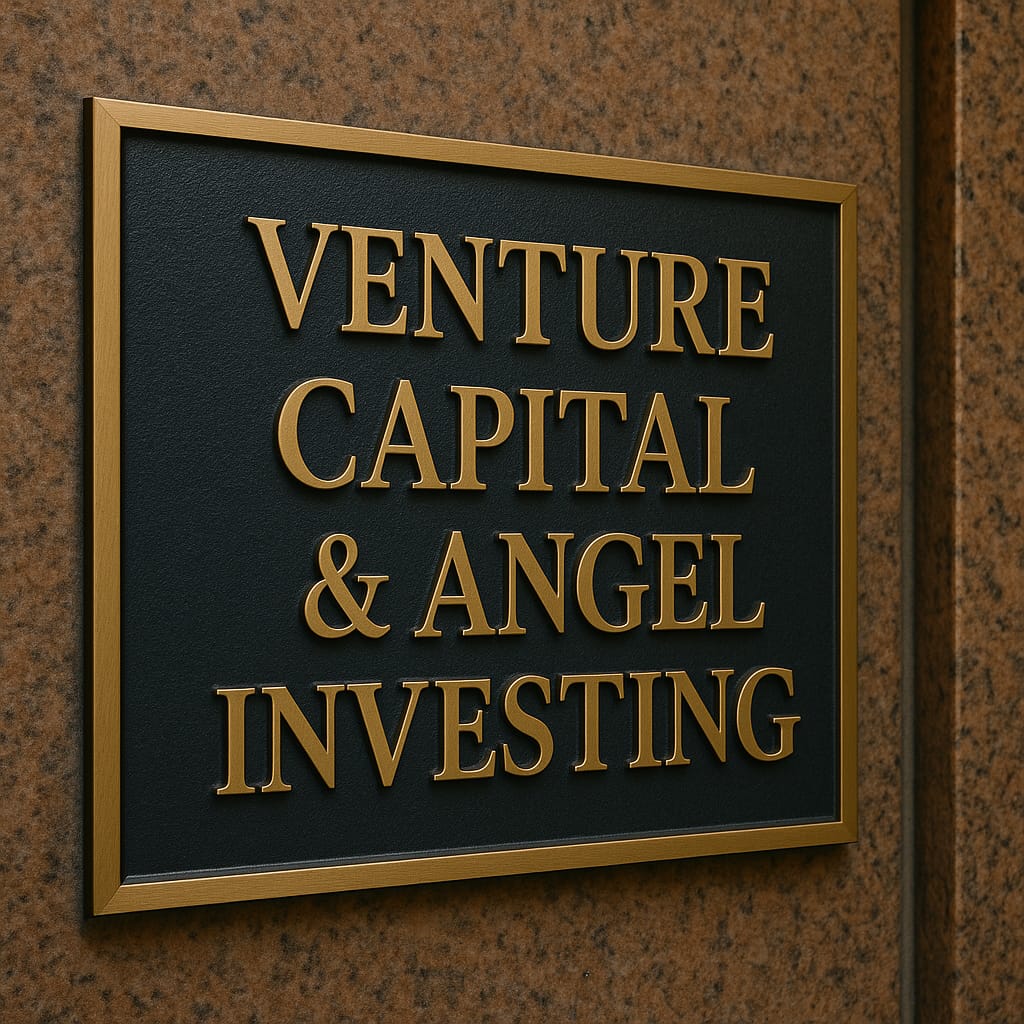
Emerging Sectors:
- AI and machine learning startups
- Climate tech and sustainability
- Bioengineering and longevity
- Decentralized finance and blockchain platforms
Many UHNW individuals invest through syndicates, fund-of-funds, or directly via trusted networks to gain access to top deal flow.
“Fortunes are made when you invest in what the world will need 10 years from now.”
— Marc Andreessen, VC pioneer
🔁 Real Asset Alternatives
Beyond traditional funds, wealthy investors also diversify with:
- Farmland – A hedge against inflation and a provider of real yield
- Timberland – Long-term asset with sustainable income via harvesting cycles
- Infrastructure Funds – Toll roads, airports, energy grids — often with government-backed contracts
- Litigation Finance – Funding lawsuits in exchange for a share of settlements
These “boring” alternatives can offer stable, low-volatility returns with real-world backing, making them a favorite among family offices.
📊 Key Considerations for Entering Alternatives
- Accreditation: Many require investor accreditation or institutional relationships
- Lock-Up Periods: Capital may be tied up for 3–10+ years
- Due Diligence: Vet managers, funds, and structures carefully — fees and performance vary widely
- Tax Efficiency: Some structures offer carried interest treatment, depreciation benefits, or offshore tax deferment
These private investment paths aren’t just for the ultra-wealthy anymore — but they still require connections, education, and strategic access. They’re not without risk, but for those willing to play the long game, they offer the biggest leap in wealth magnitude.
💎 Generational Wealth: Protecting & Growing a Dynasty
Creating wealth is an achievement. But preserving it across generations — that’s the real legacy. For the world’s elite, the goal is no longer just financial success; it’s ensuring that wealth becomes multi-generational without being diluted, mismanaged, or lost through poor planning.

This is where strategy, structure, and stewardship become critical. Because statistically, 70% of wealthy families lose their wealth by the second generation, and 90% by the third. The antidote? Intentional wealth governance.
🏛️ The Pillars of Generational Wealth
- Vision: A clear purpose behind the money — tied to values, mission, and goals
- Education: Teaching heirs about finance, stewardship, and family legacy
- Structure: Legal and financial frameworks that protect and guide the flow of wealth
- Governance: Systems for decision-making, conflict resolution, and evolution
- Communication: Transparency and trust between generations to avoid secrecy or conflict
“A family that communicates, educates, and plans together — preserves together.”
— Wealth psychologist Dr. Jim Grubman
📚 Educating the Next Generation
Wealth without wisdom is a liability. That’s why elite families invest in financial literacy, philanthropy involvement, and real-world leadership experience for their children and grandchildren.
Methods Include:
- Hosting family wealth retreats with advisors and educators
- Enrolling heirs in multi-family office programs or wealth academies
- Assigning leadership roles in family foundations or investment committees
- Encouraging internships in industries tied to the family’s core business or investments
The earlier education starts, the better. Trust, responsibility, and context reduce entitlement and help young beneficiaries see wealth as a tool for impact, not indulgence.
🛡️ Tools to Safeguard Wealth
To ensure wealth is preserved and grown, high-net-worth families leverage advanced legal structures:
- Dynasty Trusts: Designed to hold wealth for multiple generations while avoiding estate taxes
- Family Limited Partnerships (FLPs): Offer asset protection and centralized control
- Private Trust Companies: Allow families to serve as their own trustee — with increased customization and privacy
- Insurance Wrappers & PPLI: Private placement life insurance strategies to protect and grow assets tax-efficiently
- Spousal Lifetime Access Trusts (SLATs): Useful for reducing estate size while keeping access within the family
Each structure serves a role in minimizing tax liability, protecting assets from lawsuits or divorce, and ensuring legacy instructions are followed to the letter.
💼 Family Governance in Action
The wealthiest dynasties function more like corporations — with boards, voting procedures, succession plans, and even mission statements.
Best Practices:
- Create a Family Constitution: Outlines values, vision, protocols, and rules for wealth use
- Establish a Governance Council: Includes both family members and outside advisors
- Annual Reviews: Revisit estate plans, investment performance, and philanthropic impact
- Conflict Mediation Systems: Built-in safeguards to resolve disputes before they fracture the family
Families that adopt governance models not only preserve wealth but build identity — a sense that being part of the family means standing for something.
🧬 Passing Down More Than Money
One of the most powerful aspects of generational wealth isn’t financial — it’s philosophical. The transmission of:
- Stories of how the wealth was created
- Values that define the family identity
- Expectations for community involvement
- Vision for what the family name should represent
Many successful families create Legacy Books, Video Archives, or Private Memoirs that document the origin story, ethics, and decisions that shaped the family’s journey. These artifacts become heirlooms in their own right — more powerful than a check or title deed.
🚀 Legacy + Wealth = Dynasty
When the wealth strategy aligns with a long-term mission, a family transcends mere affluence and becomes a dynasty. Dynasties shape culture, influence industries, and leave lasting footprints — not just in bank ledgers, but in history.
By integrating strategic investment, philanthropy, and intergenerational communication, wealthy families secure more than riches — they build a story worth continuing.
🌍 Blending Wealth with Purpose: The Rise of Impact Investing
Today’s elite investors aren’t satisfied with simply growing wealth — they want their money to make a difference. That’s where impact investing enters the conversation. This strategy blends financial return with measurable social or environmental impact, and it’s quickly becoming a top priority for next-gen wealth holders and forward-thinking family offices.
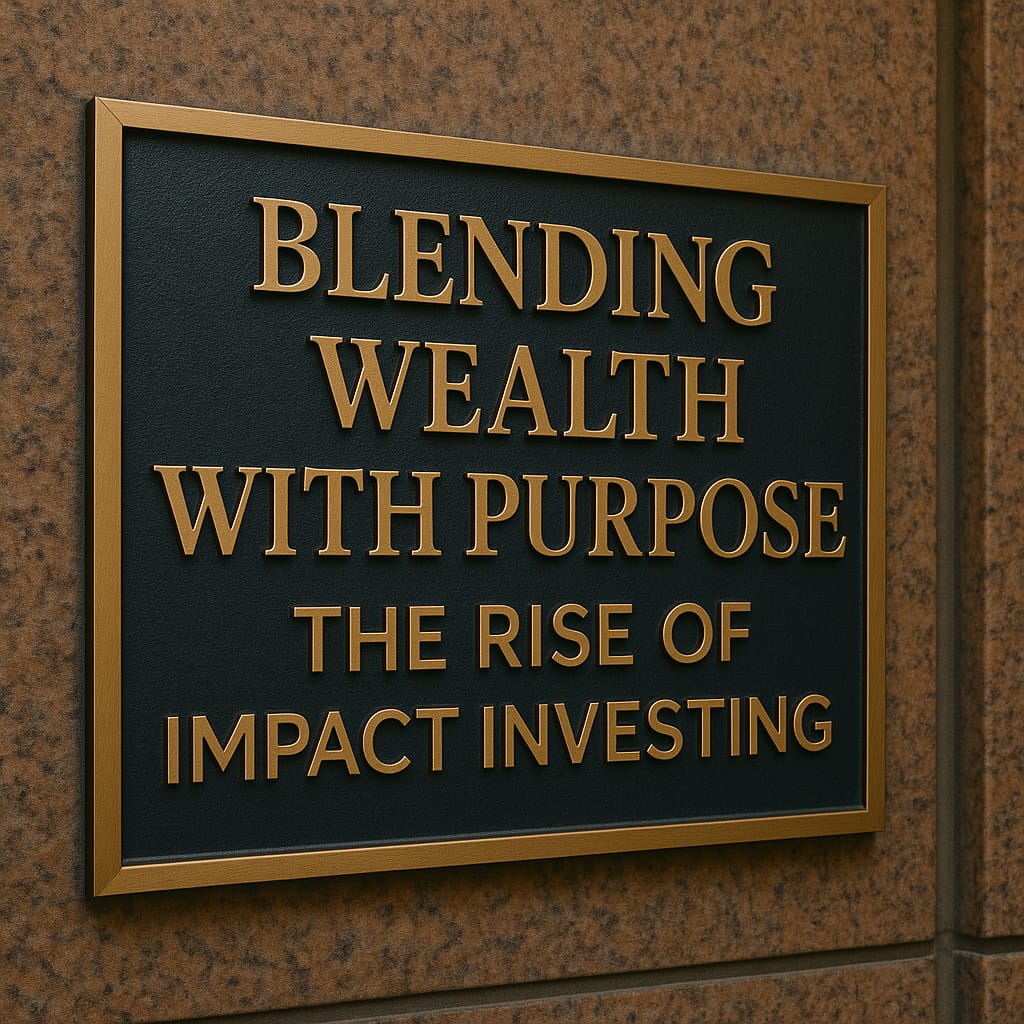
“The new ROI is return on impact. Legacy isn’t just what you leave — it’s what you build while you’re still here.”
— Clara Miller, President Emerita, Heron Foundation
What Is Impact Investing?
Impact investing refers to allocating capital to companies, funds, or projects that aim to generate positive, intentional change alongside financial profits.
This could mean investing in:
- Clean energy infrastructure
- Sustainable agriculture and water
- Financial inclusion for underserved populations
- Education technology in developing nations
- Women-led or minority-owned businesses
These investments are not donations — they are performance-based allocations made with rigorous impact metrics in mind, such as ESG (Environmental, Social, Governance) scores or the UN’s Sustainable Development Goals (SDGs).
🧠 Why the Wealthy Are Shifting Toward Purpose
- Generational Values: Younger heirs increasingly prioritize social good over status
- Reputation & Branding: Aligning wealth with ethics builds long-term trust and prestige
- Longevity of Impact: Solving world problems creates enduring influence
- Risk Management: Companies with strong ESG metrics often outperform over the long term
According to a Morgan Stanley study, 85% of individual investors — and 95% of millennial investors — are interested in sustainable investing. For family offices, this isn’t a trend — it’s a strategic pivot.
🔎 Vehicles for Impact Investing
There are multiple pathways for integrating impact into your wealth strategy:
- Public ESG Funds: Mutual funds and ETFs that screen for environmental and social metrics
- Private Impact Funds: More exclusive, often thematic investments in emerging markets or specific sectors
- Direct Investment in Social Enterprises: Funding mission-driven companies through private equity or angel rounds
- Green Bonds & Sustainability-Linked Notes: Debt instruments tied to eco-focused outcomes
- Program-Related Investments (PRIs): Philanthropic capital used in a for-profit context under IRS-approved guidelines
These investments can be filtered for risk appetite, geography, industry, and impact priority — giving investors a high degree of customization.
🌐 Global Influence, Local Results
The beauty of impact investing lies in its dual-layered outcome: it makes waves globally but touches lives locally.
Examples:
- A luxury real estate investor might build net-zero carbon villas in environmentally sensitive zones
- A fashion entrepreneur might allocate profits to anti-trafficking initiatives in supply chains
- A tech mogul might fund AI startups solving accessibility issues for the disabled
Impact investing allows the wealthy to be architects of better systems, not just participants in them.
🏆 Measuring Real Results
A major shift in the impact investing world has been the emphasis on accountability. Today’s top impact funds report on:
- Carbon offset per dollar invested
- Jobs created in underserved communities
- Number of children educated or vaccinated
- Access to clean water or energy expanded
- Gender parity among leadership teams funded
This level of precision allows investors to track impact with the same seriousness as returns — creating a more meaningful benchmark for success.
🔄 Aligning Purpose with Portfolio
Impact investing isn’t just a niche — it’s a lens through which the wealthy now view all their holdings. From rebalancing traditional portfolios to shifting foundation mandates, the question is no longer should you invest with purpose, but how soon can you start?
The integration of ethics, impact, and finance is not a compromise — it’s an evolution. And those who master this strategy lead not only in wealth but in influence, respect, and legacy.
✅ Final Thoughts: The Luxury of Strategic Wealth
True luxury isn’t flaunting capital — it’s controlling it with precision and purpose. For the ultra-wealthy, the portfolio becomes a canvas of influence: an opportunity to shape industries, change lives, and build a future that reflects their highest values.
From tangible assets like art and real estate to intangible ones like legacy and impact, every dollar is a vote — not just for financial gain, but for what kind of world you believe in.
You’ve earned the wealth. Now it’s time to elevate it.
🔗 Explore More in Investments & Wealth
- Legacy & Philanthropy: Creating Impact That Outlives You
- [Wealth Preservation Strategies for the Ultra-Successful](coming soon)
- [Tax Optimization & Global Structuring for High Net-Worth Individuals](coming soon)
- [Private Equity vs. Public Markets: Where the Smart Money Moves](coming soon)





